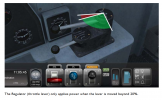Inversnecky
Member
Hitherto on Train Simulator, I've just driven the Armstrong Powerhouse Class 37, which has a throttle which more or less adds power from initial application (10% plus), but I've been trying out the RETB scenario on the Scottish Western Lines using the supplied 37.
In both the West Highland Line Extension and West Highland Line South, the throttle on the 37/0 and 37/4 acts differently from the AP 37:
"The Regulator (throttle lever) only applies power when the lever is moved beyond 20%."
"Driving the Class 37/0 The locomotive as modelled has been carefully designed to be driven in the same way as the real thing.... The power handle on this locomotive operates in two stages. In the first part of its travel, the engine is held at idle speed and the torque imposed on it by the generator is controlled proportionately to the handle position. In the second part of its travel, the torque permitted is at the maximum value, and the rotation speed of the engine is controlled by handle position."
Why is there such a variance with the way the AP throttle works? Is one more in tune with the real loco than the other, or was there indeed this sort of variance in subclasses of the real 37s?
Hoping there is someone here who has driven a real 37, who can shed some light on this?
In both the West Highland Line Extension and West Highland Line South, the throttle on the 37/0 and 37/4 acts differently from the AP 37:
"The Regulator (throttle lever) only applies power when the lever is moved beyond 20%."
"Driving the Class 37/0 The locomotive as modelled has been carefully designed to be driven in the same way as the real thing.... The power handle on this locomotive operates in two stages. In the first part of its travel, the engine is held at idle speed and the torque imposed on it by the generator is controlled proportionately to the handle position. In the second part of its travel, the torque permitted is at the maximum value, and the rotation speed of the engine is controlled by handle position."
Why is there such a variance with the way the AP throttle works? Is one more in tune with the real loco than the other, or was there indeed this sort of variance in subclasses of the real 37s?
Hoping there is someone here who has driven a real 37, who can shed some light on this?




